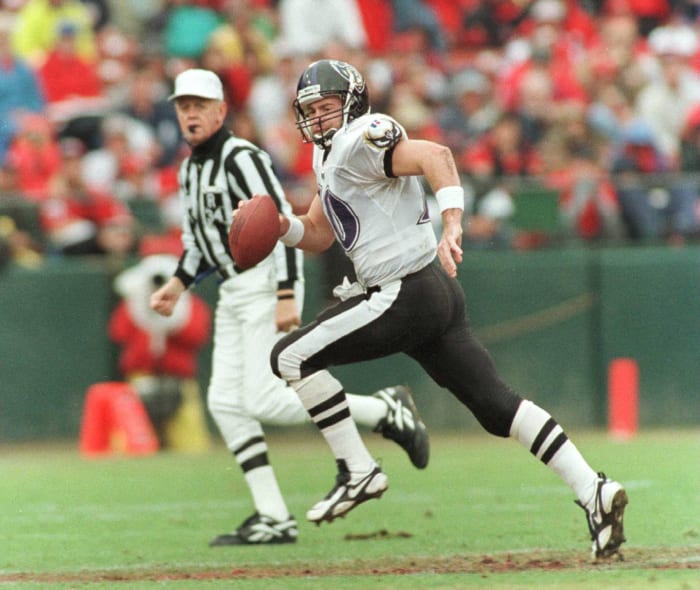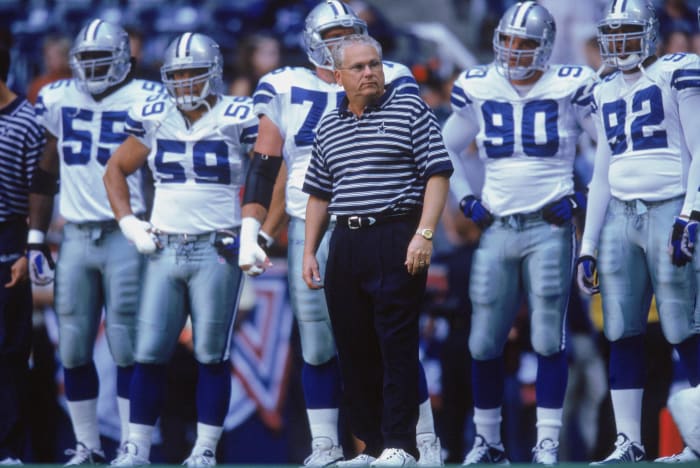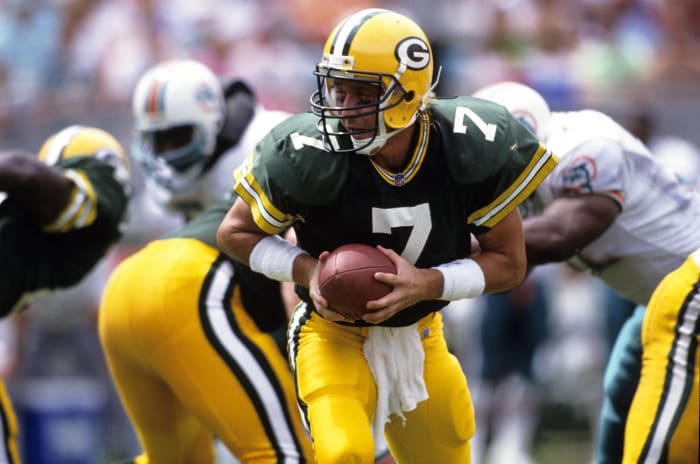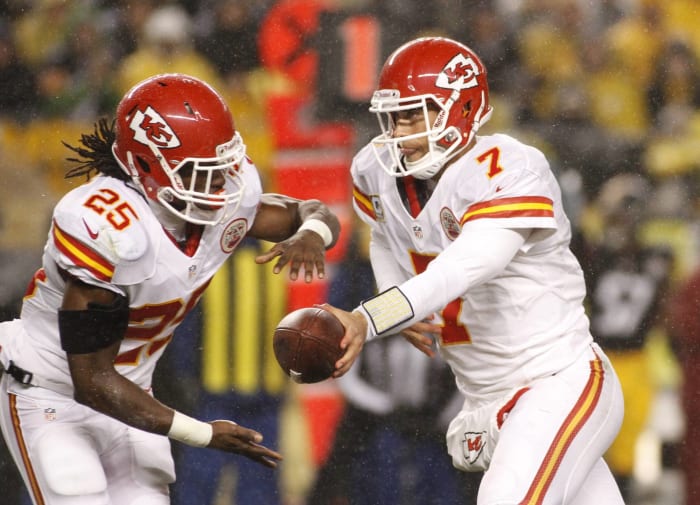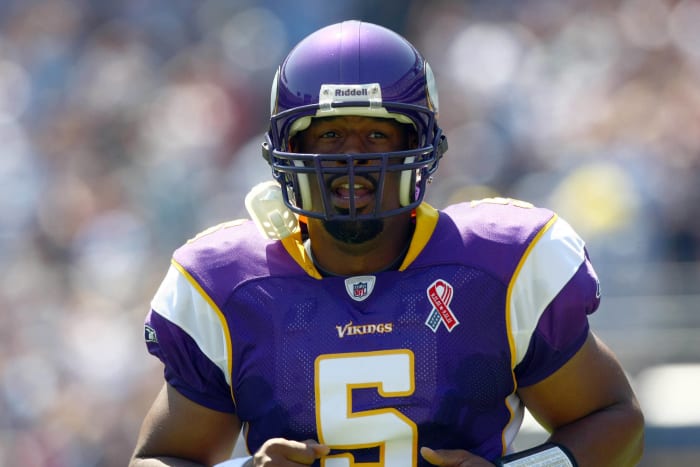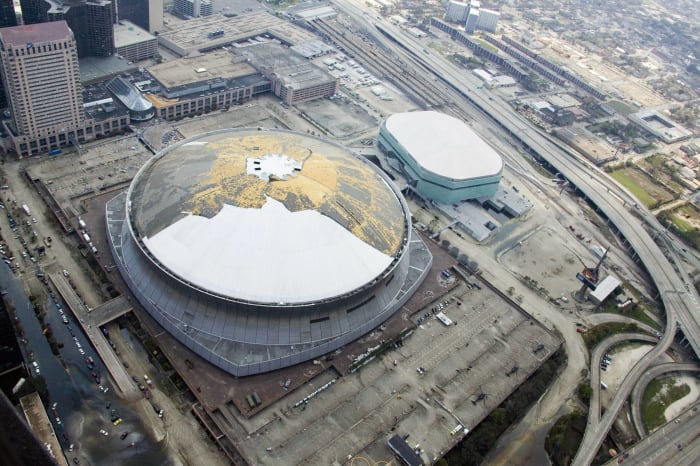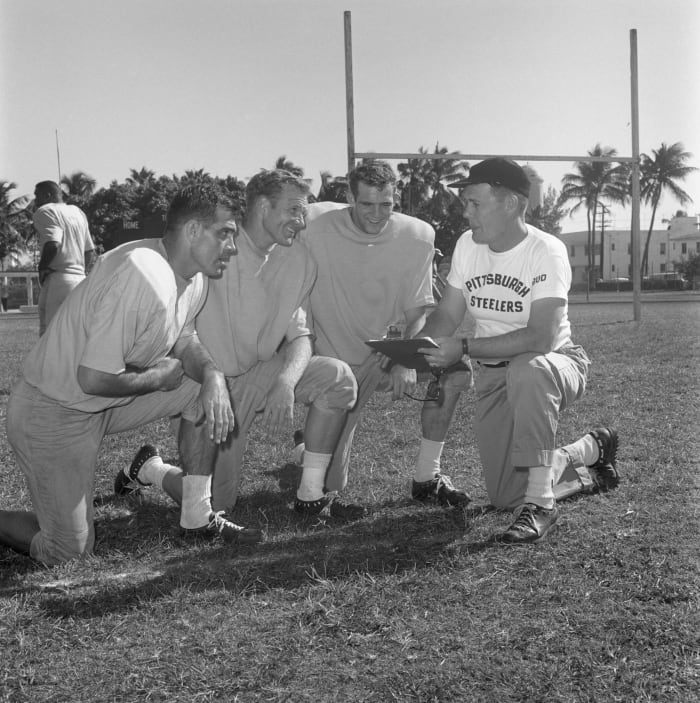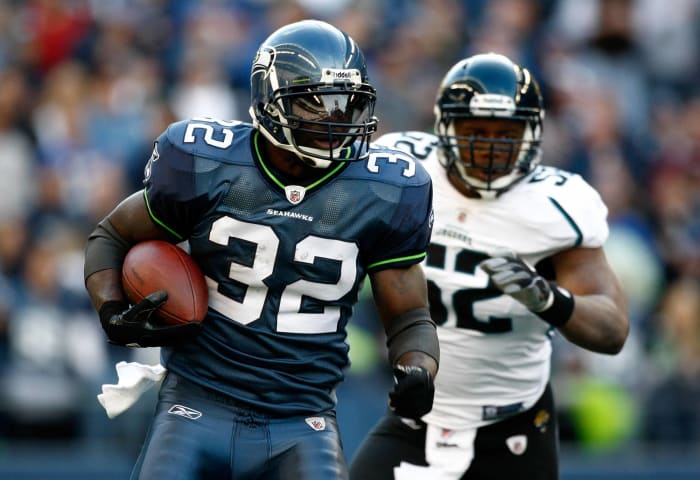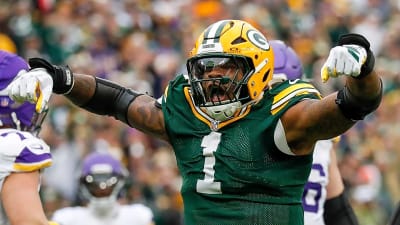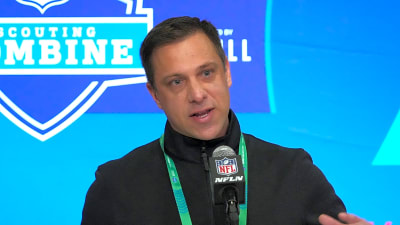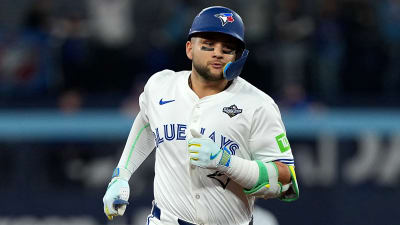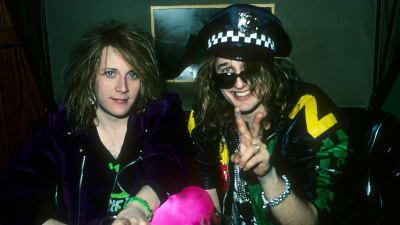These 10 franchises have been among the best and most iconic in the NFL over the last decade or so — franchises that, for the most part, exude success and a championship pedigree.
Of course in professional sports you can't get around the bad times that come up every now and then...whether it is in a single season or over a bad stretch of seasons where the talent (and/or coaching) isn't up to par — where even the best was at its worst.
So let's look at 10 NFL franchises and dig into the last time they were really, really bad with hopes of making a Super Bowl more a dream than a reality. These were the tough times that make the best times feel even better.
Otto Greule Jr / Stringer / Getty Images
Record from 1996-1998: 16-31-1
Worst season: 1996 (4-12)
The Ravens have a rather strange history because while they were technically a relocated team (they moved from Cleveland in 1996), their history is one of an expansion franchise. The Ravens have mostly avoided the pitfalls that most franchises fall into, but there was still the relocation/expansion years. The Ravens moved to the cavernous Memorial Stadium and hired Ted Marchibroda to be their "first" coach. Baltimore struggled in that first season, going 4-12, which is still the worst record in franchise history. That year was also Jonathan Ogden's and Ray Lewis' rookie season and as the Ravens continued to struggle (6-9-1 in 1997 and 6-10 in 1998), they racked up other picks who would contribute to their 2000 Super Bowl championship team.
Ronald Martinez/Allsport/Getty Images
Record from 2000-2002: 15-33
Worst season: 2002 (5-11)
The Dave Campo years were a bit of a gut-punch to Cowboys fans all over the country. After winning three Super Bowls in four years, from 1992 to 1995, Dallas struggled to get back on the big stage. Barry Switzer's time fizzled out after winning Super Bowl XXX with Jimmy Johnson's team, and Chan Gailey's two seasons ended in playoff losses in the wild-card round. Campo not only couldn't turn things around, but he also unfortunately oversaw the end to "The Triplets" era. Michael Irvin's spinal cord injury had ended his career in 1999, and Deion Sanders already left for the Washington Redskins. Campo's first season in Dallas became Troy Aikman's final one, as Aikman had suffered from multiple concussions with a hit from the Redskins LaVar Arrington being the final play of his career. Campo also was around for some of the more embarrassing moments in Cowboys history, like when Terrell Owens celebrated a touchdown on the Texas Stadium star and when they lost in Week 1 of the 2002 season to the expansion Houston Texans. The one bright spot was Emmitt Smith breaking Walter Payton's all-time rushing record in 2002...though even that was in a loss. Dallas finished 5-11 in all three of Campo's seasons, and Bill Parcells was hired to replace him. Strangely, Campo was rehired in 2008 to be the Cowboys' secondary coach.
Ronald C. Modra/Getty Images
Record from 1986-1988: 13-33-1
Worst season: 1988 (4-12)
The 1960s Packers are an iconic dynasty in sports that holds a special place in NFL lore. When it all ended after Super Bowl II with Vince Lombardi's retirement, it took another 25 years for the franchise to even sniff that kind of success. From 1973 to 1992, the Packers made exactly one playoff appearance — and that was a 5-3-1 effort in the strike-shortened 1982 season. While the Packers have enjoyed fielding either Brett Favre or Aaron Rodgers as their quarterback since 1992, just before then Green Bay was floundering and struggling to get back to being a premier franchise. Forrest Gregg's first two seasons as head coach were just like Bart Starr's final season as head coach: 8-8. Gregg would dump all the older players and begin a youth movement that produced some lean years. From 1986 to 1988 the Packers went 13-33-1 despite Gregg resigning and Lindy Infante taking over after the 1987 season. This was the Don Majkowski era..the answer to the trivia question of who the last Packers starter was before Favre and Rodgers. Even though the 1989 Packers turned it around with a 10-6 record, that draft saw them select Tony Mandarich with the No. 2 overall pick — which is widely regarded as one of the biggest busts in NFL history.
Justin K. Aller/Getty Images
Record from 2007-2012: 29-67
Worst season: 2012 (2-14)
Let me first point out that while this six-year stretch was pretty bad, the Chiefs did have a 10-6 season in 2010 and made the playoffs. The other five seasons were utter garbage.
Let's start at the beginning, in 2007. Herm Edwards was in his second season after leading the Chiefs to the postseason the previous year, but things got drastically worse. Contract issues with Tony Gonzalez hovered over the team, and Trent Green was dealt to the Dolphins. Bad quarterback play sunk the team, as it went on a nine-game losing streak to end the season at 4-12. The most famous play during the Chiefs' 2008 season was when, in the opener, Bernard Pollard hit Tom Brady in the knee, tearing his ACL. That season ended with a franchise-worst 2-14 record. The 2009 season (under new head coach Todd Haley) wasn't much better, with the team going 4-12 again. Haley would lead KC to that 2010 playoff season and things were looking up, but injuries to Jamaal Charles and Matt Cassell saw a 5-9 start to the 2011 season and Haley's firing. Romeo Crennel won two of the final three games of the season and earned the full-time head coaching job in 2012. Crennel's lone season as head coach was a tragic one on and off the field. The offense was absolutely horrendous (despite Charles rushing for 1,509 yards), and the team again finished 2-14. One of those wins came the day after linebacker Jovan Belcher murdered his girlfriend and then went to Arrowhead Stadium and killed himself. After the season Crennel and GM Scott Pioli were fired, and Andy Reid was hired. All told, the Chiefs went 29-67 during those six seasons.
Donald Miralle/Getty Images
Record in 2011: 3-13
The Vikings are truly one of the more amazing franchises in the NFL. They've had only 10 seasons of 10 or more losses during the 58 years since the franchise's founding. They've managed to avoid a prolonged rebuild in their history and have only once failed to make the playoffs in more than three seasons since the first seven years of existence. But there was the 2011 season, Leslie Frazier's first full season as head coach (Frazier went 3-3 in 2010 as an interim head coach) and the only season for quarterback Donovan McNabb. McNabb went to Minnesota in a trade with the Redskins and continued to disappoint, going 1-5 before being benched in favor of rookie Christian Ponder. Ponder had a rough time of things, throwing 13 TDs and 13 INTs for the season. The biggest news of that season was star running back Adrian Peterson tearing his ACL on Christmas Eve and failing to reach the 1,000 yard mark for the first time in his career. (Amazingly, Peterson not only recovered in time to start the 2012 season but also rushed for over 2,000 yards to win MVP honors that year.) The Vikings finished 3-13, their worst record since 1984. Like always in Vikings history, this was just a blip and not a trend. Peterson's MVP season led Minnesota to the 2012 postseason where it lost to the rival Packers in the wild-card round.
Andrew D. Bernstein/Getty Images
Record from 1989-1993: 19-61
Worst season: 1990 (1-15)
If you are under the age of 30, you may have never known the Patriots to be anything other than a dynastic organization with a great owner, coach and quarterback. However, before there was Robert Kraft, Bill Belichick and Tom Brady, there was Victor Kiam. Kiam bought the Patriots from the financially strapped Sullivan family in 1988, just a few years after the team made its first Super Bowl. On the field, the Pats were horrible. Attendance was down, and they had a mess of a roster. Longtime coach Raymond Berry was fired and replaced with Rod Rust, who in his lone season led the team to its worst record ever (1-15 in 1990). Ironically the only win that season turned into the worst moment of the Kiam era when reporter Lisa Olson allegedly was harrassed in the Patriots locker room. Rust would be fired and replaced with Dick MacPherson who didn't fare much better. After a six-win season in 1991, the Patriots crashed to a 2-14 mark the following year. Kiam would eventually sell the team to James Orthwein, who would hire Bill Parcells as head coach and Belichick as defensive coordinator. They would use the top overall pick in the 1993 draft on Drew Bledsoe. Strong rumors the franchise was moving to St. Louis subsided when Orthwein sold the team to the owner of Sullivan Stadium, Robert Kraft, in 1994. The rest is history.
Jerry Grayson/Helifilms Australia PTY Ltd/Getty Images
Record in 2005: 3-13
No NFL team in modern history had to experience what the Saints went through in 2005. Two weeks before the season began, Hurricane Katrina hit New Orleans directly, decimating the city and causing extensive damage to the Saints' home field, the Louisiana Superdome. Not only was the Superdome severely damaged, but it also was used to house displaced residents, leaving it filled with filth . The city nor its stadium was fit to play football in, so the Saints' home opener against the Giants was played in New Jersey. The Saints were essentially a road team during the 2005 season, splitting home games among East Rutherford, New Jersey (one game), San Antonio (three games) and Baton Rouge (four games). Their only "home" win was over the Bills in San Antonio, though oddly enough they did win a game in East Rutherford — a road game against the Jets. The team would go 3-13 on the season, and head coach Jim Haslett would be fired. As the season wore on, there was doubt that the Saints would ever play in New Orleans again as San Antonio, Los Angeles and Toronto were lobbied as possible relocation sites. There were also groups being formed to possibly buy the team from Tom Benson to keep it in Louisiana. The team would indeed return to New Orleans and the Superdome, with its first game back in the stadium on Sept. 25, 2006, an emotional win over the rival Atlanta Falcons on "Monday Night Football." It also was the first season for both the franchise's greatest coach (Sean Payton) and greatest player (Drew Brees).
Joseph Patronite/Getty Images
Record from 1997-1999: 14-33
Worst season: 1998 (3-13)
Since the turn of the century, the Eagles have rarely had a bad season. They've made the playoffs in 12 of the last 19 seasons and have had double-digit losses just twice since 2000. Just before that string of success were three years of tough times when Ray Rhodes was the head coach. Rhodes, who was hired after the team fired the maligned Rich Kotite, got off to a good start by making the playoffs in 1995 and 1996 with a pair of 10-6 records. Trouble loomed, though, as he benched star Randall Cunningham in favor of Rodney Peete. Peete would suffer a knee injury in 1996, and the team would move on to Ty Detmer, who played admirably but wasn't a franchise QB. By that time, the players had grown tired of Rhodes' authoritative style, and the team bottomed out to a 3-13 mark in 1998. The offense was dismal, and the once-vaunted defense was a shell of itself. Rhodes was fired and replaced with Andy Reid, who used the No. 2 overall pick in the 1999 draft to select Syracuse's Donovan McNabb. While the team struggled in McNabb's first season, he and Reid turned around Philly's fortunes the following year by going 11-5 and making the playoffs.
Bettman via Getty Images
Record from 1964-1970: 24-71-3
Worst season: 1969 (1-13)
The Steelers have been a model franchise that has enjoyed consistent success over the last half-century. Their record-tying six Super Bowl championships is a testament to the Rooney family's stewardship of one of the NFL's oldest franchises. It wasn't always like that, though, as the Steelers were once one of the most unfortunate franchises in sports. From 1933 to 1971, Pittsburgh made the postseason just once (1947). The mid-to-late 1960s featured the worst stretch of seasons as the Steelers couldn't find their franchise quarterback...ironic since Western Pennsylvania was producing some of the league's top signal-callers. In 1965, Mike Nixon's lone season as head coach, the team had a minus-30 turnover ratio and threw just 10 touchdown passes to 35 interceptions. Bill Austin took over for three years before being dismissed in favor of Chuck Noll in 1969. Noll's first season was a 1-13 nightmare, but it was by design as he stripped down the roster to rebuild through the draft, becoming a seminal moment in the team's history. "Mean" Joe Greene was the defensive Rookie of the Year that season, and the team would use the top overall pick on Terry Bradshaw (and would nab Mel Blount in that draft as well). The Steelers dominated the 1970s with one of the most revered dynasties in sports: the Steel Curtain.
Jonathan Ferrey/Getty Images
Record from 2008-2009: 9-23
Worst season: 2008 (4-12)
This current decade has been outstanding for the Seattle Seahawks. Since 2010, they've finished first or second in the NFC West in all but one year (2011), and they've made the playoffs in seven of nine seasons. It is no coincidence that all this success coincides with Pete Carroll taking over the reins in 2010 and landing Russell Okung and Earl Thomas in that first draft. Prior to the Carroll era, the team was a mess. Seattle's main issue was handing out bad contracts to players who didn't work out. In 2008, the Seahawks cut Shawn Alexander and signed Julius Jones and T.J. Duckett, while in 2009 they hauled in former Bengals receiver T.J. Houshmandzadeh and Edgerrin James. Another issue was the health of quarterback Matt Hasselbeck who missed 11 games over those two seasons, though Seneca Wallace filled in admirably. Mike Holmgren announced that 2008 would be his final season as head coach, and the team fell to a 4-12 mark, its worst record since 1992 (2-14). Jim L. Mora was the preselected successor to Holmgren and while the Seahawks win total improved to five, the season was much more tumultuous. General manager Tim Ruskell quit late in the season, and Mora was sort of a lame duck. When Carroll became available, Mora was out.
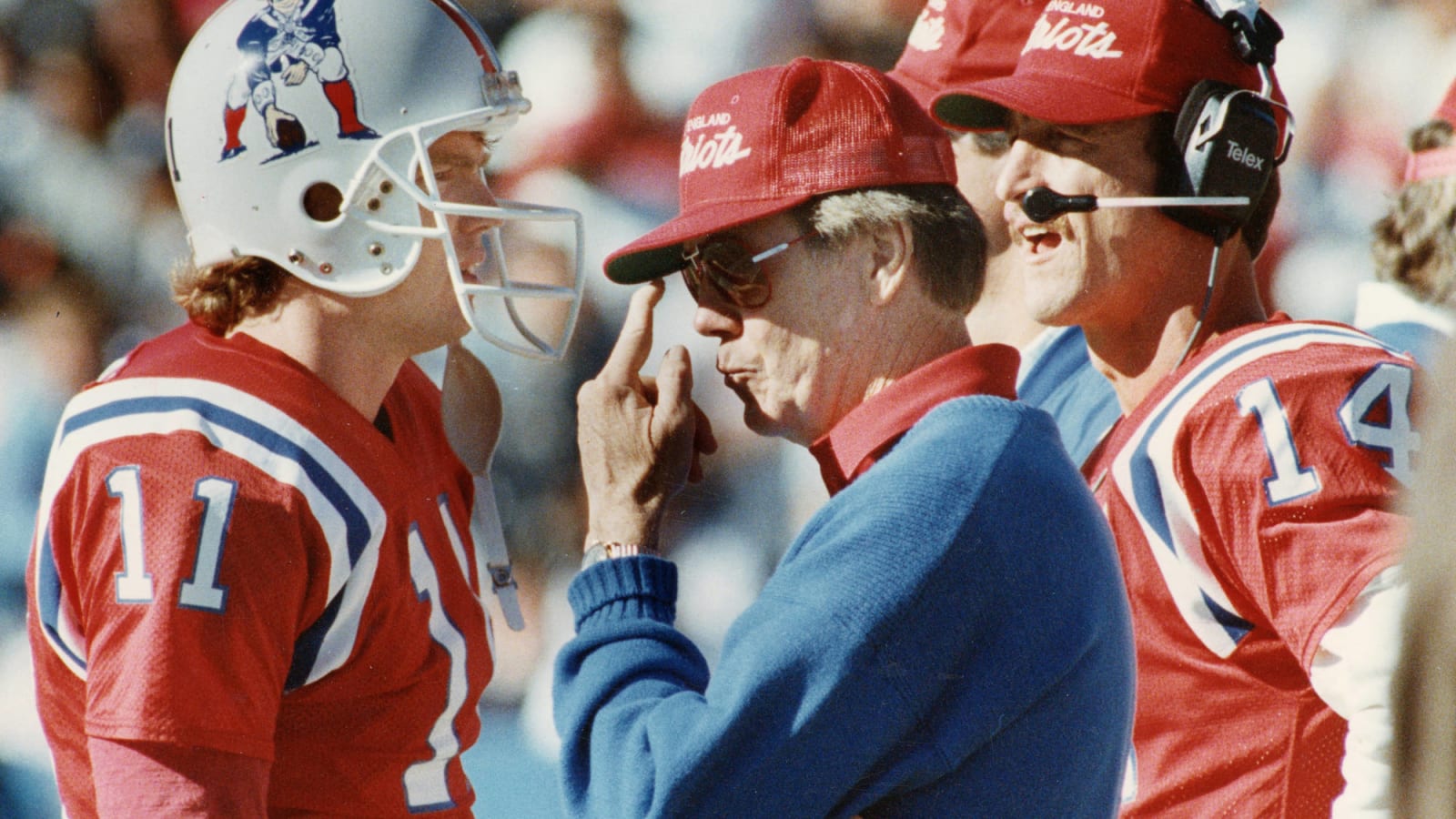
 +
+
